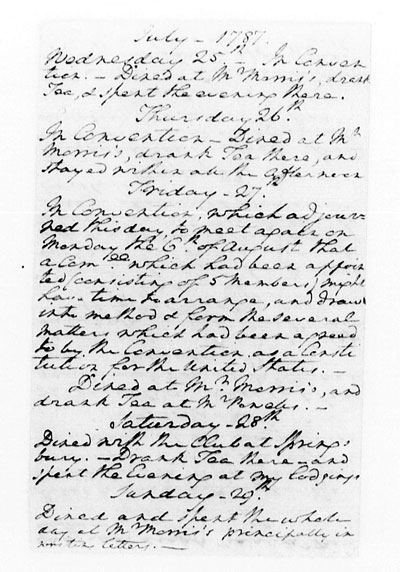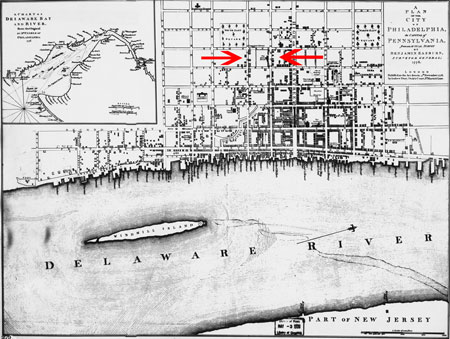Why do people no longer keep diaries? Or at least why do the majority of people today not keep journals?
In the early days of our country men such as George Washington, James Madison and Ben Franklin – to name just a few – knew the strength and the power of the written word. People of that era also took more care with their written words since frequently that was their only communication. Their recognition of the importance of words contributed to their strength as leaders and indirectly contributed to their images being used on our coinage today.
This week in 1787, George Washington was working with the Constitutional Convention in Philadelphia. His diary records were much shorter than when he was home at Mount Vernon, but the entries still provide a view into his life and activities.
Even though his penmanship is easier to read than some our contemporaries’ handwriting today, the style of writing and the age of the document still makes reading difficult.
The text states:
July 1787
Wednesday 25th – In Convention. Dined at Mr. Morris’s, drank Tea & spent the evening there.
Thursday 26th – In Convention – Dined at Mr. Morris’s, drank Tea there, and stayed within all the afternoon.
Friday 27th – In Convention, which adjourned this day, to meet again on Monday the 6th of August that a committee which had been appointed (consisting of 5 members) might have time to arrange and draw into method & form the several matters which had been agreed to by the Convention as a Constitution for the United States.
Dined at Mr. Morris’s and drank Tea at Mr. Powell’s.
Saturday 28th – Dined with the Club at Springsbury – Drank Tea there and spent the Evening at my lodgings.
Sunday 29th – Dined and spent the whole day at Mr. Morris’s principally in writing letters.
Isn’t it interesting that he always capitalized “Tea.”
Using today’s map software, it’s not clear where the “Springsbury” he mentioned was located. Several search engine results show a location in Virginia, but they were meeting in Philadelphia. Probably, the dining location was within walking distance or a short carriage ride for him and his Club – perhaps even on the water.
This map shows Philadelphia in 1776, eleven years before the Constitutional meetings. But, the State House where they met can be seen. (Map picture from the Library of Congress)
This map of the day is also interesting in that it is drawn from the perspective of the Delaware River. We are used to North being at the top of a map. In this case, the top of the map is a few degrees off of due west. One of the main streets, Market Street, which goes from the river upward and a block over from the State House actually travels slightly north of west through the city.
Of course, we’re soft today with our creature comforts, but just think about the conditions his diary brings to mind – both environment and geography. The men at the Convention wore their wool clothing and met in rooms with no air conditioning or fans to circulate the air. Being near the water in late July meant heat and humidity. Plus, many of the men, like Washington, were a long way from home and staying in places that were unfamiliar and uncomfortable, if for no other reason than they were not home. As for travel, they were dependent on their feet, where horses could carry them or boats on the river. Traveling quickly by today’s standards was not an option.
Washington’s diary provides a small glimpse of their activities of the day and makes you think about what these men accomplished with simple tools in comparison to what we enjoy with today’s technology and comforts. And, to think, they wrote the Constitution in roughly 100 days.
Their accomplishments are amazing – by any standards. Can you imagine our politicians of today putting together a document of that magnitude, complexity and comprehensiveness in those few pages? It makes one shudder to think about it.
Ending on a positive note, our coins, circulating and commemorative, over the years have honored several of the people important in our nation’s development. These coins provide physical reminders of the importance of our history.

